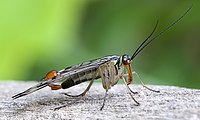
Photo from wikipedia
BACKGROUND AND OBJECTIVE To develop and validate a robust and cost-effective 3D respiratory monitoring system based on a Kinect device with a custom-made simple marker. METHODS A 3D respiratory monitoring… Click to show full abstract
BACKGROUND AND OBJECTIVE To develop and validate a robust and cost-effective 3D respiratory monitoring system based on a Kinect device with a custom-made simple marker. METHODS A 3D respiratory monitoring system comprising the simple marker and the Microsoft Kinect v2 device was developed. The marker was designed for simple and robust detection, and the tracking algorithm was developed using the depth, RGB, and infra-red images acquired from the Kinect sensor. A Kalman filter was used to suppress movement noises. The major movements of the marker attached to the four different locations of body surface were determined from the initially collected tracking points of the marker while breathing. The signal level of respiratory motion with the tracking point was estimated along the major direction vector. The accuracy of the results was evaluated through a comparison with those of the conventional stereovision navigation system (NDI Polaris Spectra). RESULTS Sixteen normal volunteers were enrolled to evaluate the accuracy of this system. The correlation coefficients between the respiratory motion signal from the Kinect device and conventional navigation system ranged from 0.970 to 0.999 and from 0.837 to 0.995 at the abdominal and thoracic surfaces, respectively. The respiratory motion signal from this system was obtained at 27-30 frames/s. CONCLUSIONS This system with the Kinect v2 device and simple marker could be used for cost-effective, robust and accurate 3D respiratory motion monitoring. In addition, this system is as reliable for respiratory motion signal generation and as practically useful as the conventional stereovision navigation system and is less sensitive to patient posture.
Journal Title: Computer methods and programs in biomedicine
Year Published: 2018
Link to full text (if available)
Share on Social Media: Sign Up to like & get
recommendations!